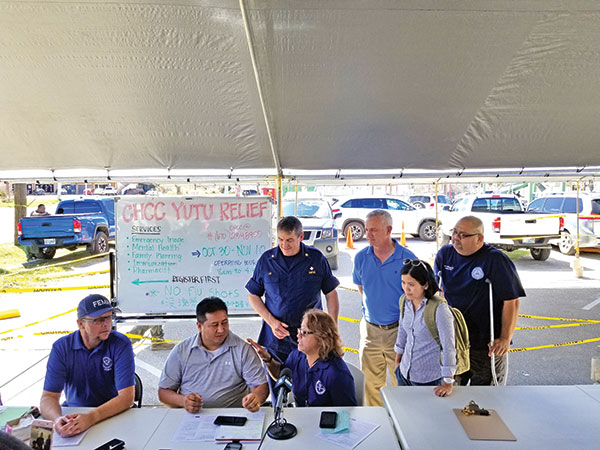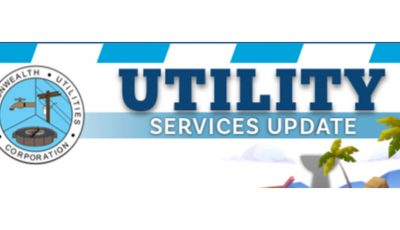Typhon debris cleanup goes to villages

Gov. Ralph DLG Torres, seated center, and Commonwealth Healthcare Corp. CEO Esther L. Muña, seated right, discuss an issue at the end of yesterday’s press conference at the San Antonio Clinic. (Jon Perez)
Government personnel—both local and federal—are set to start clearing villages of typhoon debris and assist in the needs of people whose homes were damaged by Super Typhoon Yutu.
In a news briefing yesterday at the San Antonio Clinic, Gov. Ralph DLG Torres said that more than 3,000 houses were destroyed when Yutu pummeled the island last month, based on the assessment they did with their federal partners.
The Federal Emergency Management Agency, through Region IX deputy regional administrator Bill Roche, and the Department of Defense have been helping the CNMI government in its assessment work.
Torres said both federal and local government personnel are done with clearing major roads of typhoon debris like tin roofs, tree branches and leaves, and broken power poles and lines.
“We’re going to the second stage, where we will be going around the villages…to clean up,” he said.
Torres assured that government representatives also regularly visit homes and the shelters to assess the situation and the progress of the recovery efforts.
He added that waivers will be distributed to homeowners to allow government personnel to help clear their areas of debris and other materials.
“Our personnel will be walking around and have these waivers. The waivers would allow personnel from the [Saipan] Mayor’s Office and the military to enter their premises. They need to fill out those forms in order for them to receive assistance. At the same time, we will give tents to help the people who are displaced.”
Roche said it is too early to determine who needs housing installation assistance. “Right now, we’re focused on interim housing solutions. …We are looking at temporary arrangements like tent structures.”
He added that they are also discussing assistance to homeowners whose houses were totally destroyed by Yutu. “We’re also looking for long-term housing solutions. …There’s an array of avenues that we could take. It is premature for me to talk of this right now. But we’re going to work with the governor to determine what [assistance we can offer] to the community in getting things back.”
Utilities restoration
Power and water distribution are also slowly being restored throughout the island. Torres said that things are a lot faster compared to when Typhoon Soudelor ravaged the island more than three years ago.
“One thing that we’re fortunate is that the north side is not as damaged as the south side. On the second day, we had the hospital up and running. Lower Navy Hill, Gualo Rai, and Puerto Rico also had power up quickly,” said Torres.
“Now we have all the way up to Capit[a]l Hill and some of the residents have power and water there. From the power plant to up north—that is already energized. Of course, some of the homes that were damaged still need to get connected.”
He added that water has also started to flow across the island. “It is not yet 24 hours but they will be staggering [distribution] throughout the day to different villages. Again, we’re filling all of our wells and making sure the pipes are not broken or damaged.”
Torres said making sure all the pipes are in good condition is a critical part in water distribution. “Even if we put water into the villages, if we have massive destruction of pipes, we’re losing the water that needs to be distributed. And we should not allow this to happen.”



























